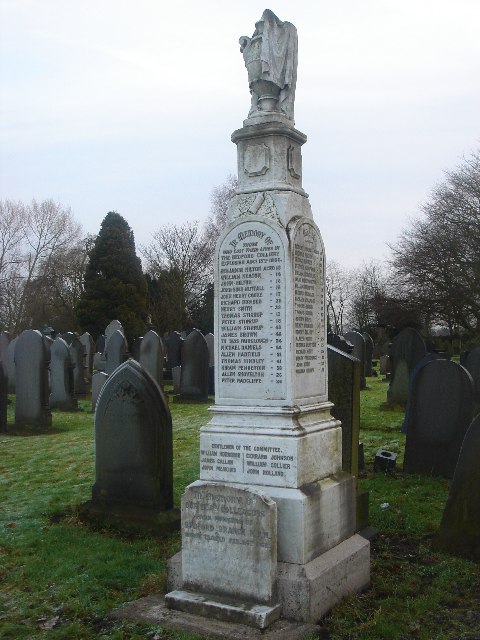The Bedford CollieryColliery in Leigh sunk by John Speakman at Wood End Farm in the northeast part of Bedford in 1875 explosion occurred on Friday 13 August 1886, when firedampDamps is a collective name given to all gases other than air found in coal mines in Great Britain. The chief pollutants are carbon dioxide and methane, known as blackdamp and firedamp respectively. ignited and caused the death of thirty-eight miners at Bedford No.2 Pit in Leigh, on the Lancashire CoalfieldThe Lancashire and Cheshire Coalfield in North West England was one of the most important British coalfields. Its coal seams were formed from the vegetation of tropical swampy forests in the Carboniferous period more than 300 million years ago..
Bedford Colliery, usually known as Wood End Pit, was sunk in BedfordSuburb of Leigh in Greater Manchester, one of the three ancient townships that merged in 1875 to form the town of Leigh. by John Speakman between 1875 and 1878. The colliery had two shafts. The Seven feet mine[a]In this part of Lancashire a coal seam is referred to as a mine and the coal mine as a colliery or pit. was fiery and only safety lamps were allowed underground.[1]
Explosion
On the day of the disasterMining disasters in Lancashire in which five or more people were killed occurred most frequently in the 1850s, 1860s and 1870s. 159 men and boys were underground working a shift that started at 6.00 am and would have ended mid-afternoon. The disaster took place at about 10.45 am in the Crombouke mine at a depth of about 530 yards (485 m) and 700 yards (640 m) from the pit bottom. Miners from other areas of the pit were wound to the surface after they became aware of the explosion when afterdamp spread into their workings. One man working at the seat of the explosion, John Woolley a dataller, (day wage man) survived, and though burned, managed to get to the bottom of the shaft. When the alarm was raised, the pit manager W. Horrobin, underlooker James Calland and the mine owner’s son, Harry Speakman led a rescue party to investigate but were impeded by the presence of afterdamp. According to Calland the afterdamp was “very strong and makes the men very dizzy. When they have this feeling they have to come up quickly to the fresh air”. The Mines Inspector, Joseph Dickinson of Pendleton was contacted by telegraph.[2][3]
The explosion occurred before the formation of mines rescueSpecialised job of rescuing miners and others who have become trapped or injured in underground mines because of accidents, roof falls or floods and disasters such as explosions caused by firedamp. teams but assistance arrived from nearby collieries and an exploring party of men from Bickershaw Colliery, Astley and Tyldesley CollieriesColliery company formed in 1900, became part of Manchester Collieries in 1929, and some of its collieries were nationalised in 1947. and the Wigan Coal and Iron Company went underground but considered there would be no survivors. The underground fires were eventually extinguished and bodies brought to the surface.[2]
Aftermath
News of the explosion travelled quickly and by 11 o’clock a crowd of women had arrived at the pit. In the evening a crowd, estimated to be between eight and ten thousand, gathered at the pit head. The burned and mutilated bodies of the 38 men who died were brought to the surface wrapped in tarpaulins and taken to the wheelwrights shop and the joiners shop which were used as a mortuary. The youngest victim was 15 years old and the oldest 65. The average age of those who died was 32 and 48 children were left fatherless. Some families lost more than one member.[2][3]
The colliery subscribed to the Lancashire and Cheshire Miners’ Permanent Relief SocietyForm of friendly society started in 1872 to provide financial assistance to miners who were unable to work after being injured in industrial accidents in collieries on the Lancashire Coalfield. whose officials attended at the colliery.[1] A committee of local dignitaries was formed to raise monies for the “Relief of Widows, orphans and others placed in distress by the explosion” and an appeal advertised in The Times newspaper.
Inquest
The coroner’s inquest was not heard until 23 September 1886 so that John Woolley, who had survived the explosion, could give evidence. The coalface where the explosion occurred was being worked on the retreating principle. Headings had been driven into the coal and a working face established between them. As the coal was worked back along the headings, waste material accumulated in the goaf behind it. Pit props were progressively removed and the roof was allowed to subside into the goaf a short distance behind the working face. Woolley was removing pit props when the fracturing roof released firedamp. The flame in Woolley’s Davy lamp turned blue indicating explosive gas. Instead of reporting it, work continued. A few minutes later the flame in the lamp of a nearby miner “fired”. The established procedure should this happen was “lowering his lamp to the floor [firedamp is lighter than air] and taking it steadily into the fresh air, avoiding jerks”. Instead the miner shook it and attempted to blow it out at which point the flame passed through the gauze and caused the explosion.[2][3]
The verdict of the coroner’s jury was accidental death caused by an explosion of firedamp. The coroner commented that the fireman should spend more time examining the workings before the men went down the pit and that greater care should be taken examining the lamps. It was regretted that the gas was not reported by the prop-takers.[2]
After the explosion, the colliery owners bought 150 Masault safety lamps and 50 improved Clanny lamps, which had bonnets fitted.[2] The effect of the bonnet was to protect the gauze from draughts and reduce the risk of the flame passing through.

